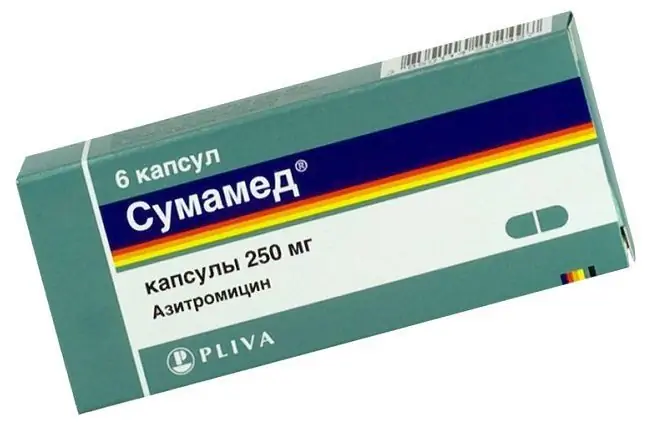- Author Rachel Wainwright [email protected].
- Public 2024-01-15 19:51.
- Last modified 2025-11-02 20:14.
Using vaseline oil for constipation
The content of the article:
- Product characteristics
- Mechanism of action
- How to take vaseline oil correctly
- Application in children
- Enemas
- Limitations and application features
- Overdose
- Release form and storage conditions
- Prevention of constipation
- Video
The use of vaseline oil for constipation has not lost its relevance, despite the large number of new laxatives. The agent softens the stool, has a weak stimulating effect on the motor function of the intestines, and causes a formed stool, which is close to normal in consistency. Vaseline oil is available in bottles of different sizes, has few contraindications, it is allowed for oral use not only for adults, but also for children.

Vaseline oil can help solve the problem of constipation one time, but will not be able to get rid of it for a long time.
Product characteristics
Vaseline oil, also called liquid paraffin, is a refined mixture of solid and liquid carbohydrates derived from petroleum. Medical vaseline oil has the form of a colorless transparent oily liquid that does not contain any harmful organic substances and their compounds. It does not have a specific smell and pronounced taste.
Mechanism of action
All laxatives are conventionally divided into groups according to the strength of their effect.
| Drugs | Action taken |
| Laxative | They soften the contents of the large intestine, ensure the discharge of soft feces that have a formalized appearance. |
| Medium strength | The result of taking is mushy or loose stools. |
| Carry |
They cause a plentiful and liquid stool, a violent contractile activity of the intestines, which provokes pain in the abdomen. |
Liquid paraffin is a laxative. It does not have a direct irritating effect on the intestinal wall, and the regulation of the physiological rhythm of bowel emptying is achieved due to:
- softening of feces;
- enveloping action on intestinal contents;
- easier mechanical movement of feces through the large intestine.
If you use the drug for oral administration, then it:
- not absorbed through the intestinal mucosa;
- does not enter the systemic circulation;
- does not affect the intestinal microflora.
Such properties of a laxative make it possible to prescribe it in the treatment of constipation in patients of different ages and to use it in women after childbirth during lactation.
How to take vaseline oil correctly
The instruction provides for the use of vaseline oil for constipation in adults in the following dosage: 15-30 ml, which corresponds to 1-2 tablespoons, 1.5-2 hours after eating, usually once a day. The action occurs 6-8 hours after administration, but individual deviations are possible both in one and the other direction.
Application in children
Vaseline oil is practically not used to treat constipation in children, but not because it is contraindicated for them. It is more difficult for a small child to find a dose and it is not very convenient to give an oil laxative to drink. The optimal amounts of the drug required for the treatment of children of different ages are presented in the table.
| Age | The amount of laxative |
| Children under one year old | 2-3 ml |
| Children from 1 to 3 years old | 5 ml (1 teaspoon) |
| Children from 3 to 7 years old | 7-10 ml |
| Children from 7 to 14 years old | 10-15 ml (2-3 teaspoons) |
If the use of the indicated dose of the laxative does not bring the desired effect, then the amount of the drug can be increased.
Enemas
To eliminate constipation, it is permissible to introduce liquid paraffin through the rectum. Setting an enema involves the introduction of 2-3 tablespoons of laxative in 100 ml of warm water through a pear of the appropriate volume. The temperature of the water-oil mixture should be approximately the same as the body temperature so as not to cause discomfort. According to patients' reviews, bowel movements are facilitated, but the procedure itself gives some inconvenience.
Limitations and application features
Liquid paraffin, despite its safety, when taken orally has some restrictions for use.
| Application features | Scroll |
| Contraindications | Individual intolerance to the drug |
| Acute inflammatory and ulcerative processes of the gastrointestinal tract: appendicitis, gastric ulcer and duodenal ulcer, ulcerative colitis, etc. | |
| Intestinal obstruction | |
| Pregnancy | |
| Poisoning with phosphorus and organophosphates | |
| Taking fat-soluble antihelminthic drugs (Vermox, Medamin, Avermol, etc.) | |
| High body temperature | |
| Side effect | Long-term use can provoke intestinal atony, nausea, decreased or loss of appetite, irritation and itching in the anus, a lack of vitamins A, K, E in the human body and the development of characteristic symptoms of hypovitaminosis. |
| Precautions | When the oil is taken internally, it is usually released from the anus for some time after the end of the course of treatment, contaminating the underwear. The use of daily sanitary pads is recommended to correct the problem. |
If the tip of the gas outlet tube or enemas used to cleanse the intestines before a diagnostic procedure or operation is lubricated with liquid paraffin, then the remnants of the agent after the manipulation are removed with a gauze or cotton swab, washed off with warm water and detergent.

Vaseline oil is used to lubricate the tip of the enema
Overdose
Liquid paraffin is a safe means of regulating the physiological rhythm of bowel movement, but this does not mean that it can be used uncontrollably. Sometimes patients, in order to achieve a quick result, exceed the dosages recommended in the instructions for the drug. This should not be done, as ingestion of an excessive amount of laxative can lead to:
- nausea;
- discomfort and pain in the abdomen;
- diarrhea (diarrhea);
- water and electrolyte disturbances.
Overdose treatment is carried out by eliminating symptoms.
Release form and storage conditions
The product is available in dark glass bottles with a cap of various sizes: 25, 30, 40, 50 and 100 ml. Storage conditions:
- temperature is not higher than 25 degrees;
- protected from light place;
- sealed packaging.
The drug is sold over the counter without a prescription. Do not use it after the expiration date. The shelf life is indicated on the packaging and is usually 5 years.
Prevention of constipation
Any laxative, including liquid paraffin, should not be used for a long time, it only temporarily eliminates problems with defecation. To achieve a lasting result and prevent the development of constipation, you must:
- balance the diet;
- normalize the drinking regime;
- to increase physical activity.
Only the fulfillment of these conditions will allow you to forget about constipation.
Video
We offer for viewing a video on the topic of the article.

Anna Kozlova Medical journalist About the author
Education: Rostov State Medical University, specialty "General Medicine".
Found a mistake in the text? Select it and press Ctrl + Enter.






